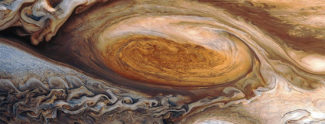Seeing red: Investigating Jupiter’s Great Red Spot
Jupiter’s Great Red Spot is a massive storm-like feature that has been raging for more than 400 years. Throughout the centuries it has been observed to expand (sometimes to twice the size of Earth), and shrink in size, but scientists are still unsure as to how it formed and what gives it its distinct red hue.
The largest planet in the solar system, Jupiter is a gas-giant that is situated between Mars and Saturn about 600 million miles away from Earth (when they are farthest apart). Like many gas giants in the galaxy, Jupiter is composed mainly of hydrogen and helium, with less than one percent as trace chemicals.

Jupiter’s Great Red Spot is a storm-like feature that has been observed for hundreds of years and is roughly the size of Earth. Credit: NASA
Researchers at the University of Wisconsin–Madison Space Science and Engineering Center have come a step closer to understanding the Great Red Spot and its chemical composition by comparing observational data from the Cassini spacecraft with laboratory simulations and models. SSEC scientist Kevin Baines believes he and his colleagues have a plausible idea as to what makes up the red spot based on available gasses in the planet and the inner atmospheric forces at play.
Unlike a hurricane on Earth, the Great Red Spot is an anti-cyclone – an area of high pressure that sends its atmosphere aloft – causing it to rotate in a counter-clockwise fashion in Jupiter’s southern hemisphere. In contrast, hurricanes (or tropical cyclones) on Earth are low pressure systems that channel air downward at the center.
The chemical composition of Jupiter is complex, but among the many possible combinations, chemicals like acetylene and ammonia are thought to be the main drivers making up the Great Red Spot’s visible layer, or chromophore. However, these chemicals by themselves cannot account for the planet’s red color. The missing ingredient? Ultraviolet light.
“The rising columns of air make the Great Red Spot one of the highest features on Jupiter,” says Baines. “Because of this, the tops of the spot’s ammonia-based clouds get radiated by the UV light of the sun more than other places on the planet. “
In other words, it gets sunburnt, or photolyzed, allowing it to react with acetylene to form reddish materials.
Baines conducted laboratory experiments with a team at the NASA Jet Propulsion Laboratory in Pasadena, CA to prove this UV-light mechanism creates reddish aerosols. The team also used a state-of-the-art radiative transfer program to identify constraints on the altitudes and opacities of the cloud layers found in the Great Red Spot.
Knowing this, Baines and his colleagues came up with the aptly named “Crème brûlée model” that accurately matches observational data captured by the Cassini space mission. As the spacecraft flew by Jupiter in 2000 on its way to Saturn, it peered into the Great Red Spot and captured what are known as spectra – a series of measurements recording how much light is either reflected or absorbed by the red spot. Later when these data were plotted to a graph, it gave scientists a chemical fingerprint used to decipher which gases were responsible for that given pattern.
“We found out the whole cloud can’t be red,” says Baines. “But you can have a relatively thin top layer be red, when that thin layer is on top of a white fluffy cloud.
As a result of their research, Baines believes the Jovian planet has the necessary ingredients to produce the Great Red Spot’s features based on their models. Its anti-cyclonic nature creates enough convection to dredge up the various chemicals and send them skyward to be irradiated by the sun. Lightning, deeper in Jupiter’s atmosphere, is also thought to be a key factor for producing the needed materials, however Cassini’s short pass over the Great Red Spot did not detect electrical discharges associated with lightning, although it has been observed elsewhere in the giant planet.
Over the centuries the Great Red Spot has undergone dramatic shifts in size and color. In the last 10 years scientists have observed the spot as it darkened and reddened, in contrast to earlier observations when the spot appeared pale-yellow in color. This may indicate a recent increase in the supply of the reactive gases like acetylene and ammonia.
Baines says Jupiter is a dynamic planet that is constantly changing, and this research is only part of the whole story. Other factors like the presence of planetary waves and lightning introduce interesting global and local dynamics to study, both on Jupiter and its neighbor, Saturn.
This work was supported by NASA and NASA Jet Propulsion Laboratory.
